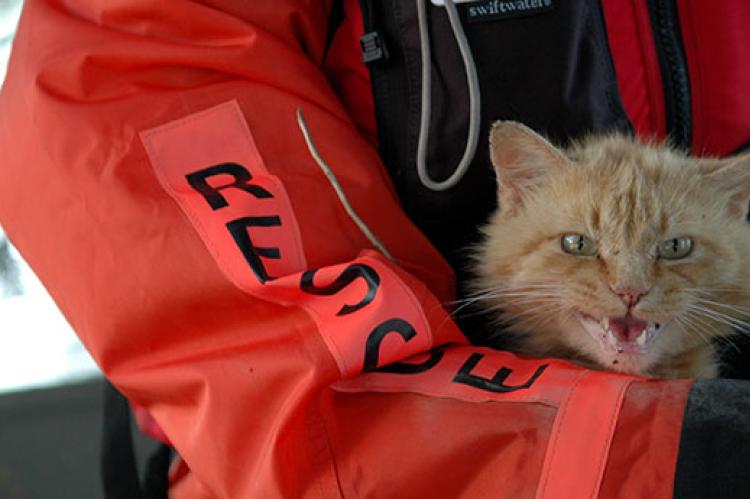Pet Emergency Kit Checklist and Plan

If there's ever a natural disaster or emergency requiring evacuation in your area, you'll want to be ready to keep not only yourself safe but also your pets. Think about how to prepare for three types of disasters:
- Immediate, such as a gas leak or house fire, when evacuation is necessary right away
- Short warning, such as a toxic spill or fire in the neighborhood, when you have to grab your pets and a few supplies and leave within a short period of time
- Seasonal disaster, such as hurricanes, floods, or wildfires, when you’ll need a plan for gathering your pets, packing up supplies, and evacuating
The following checklist can help you compile your pet emergency kit and construct a plan to keep everyone safe.
Pet emergency kit checklist
Here's a checklist of some things you can do right now to be prepared for a disaster. Please don’t wait to accomplish these tasks because it might be too difficult to do them as the emergency is occurring.
___ Put your pets' ID on their collars: your name, address, and phone number. Because cellphones and landlines might be down for a while, consider adding the phone number of a relative or friend who lives outside of your area.
___ In addition to having pets’ IDs on their collars, get your pets microchipped. Be sure to register the chip in your name and provide additional phone numbers.
___ Have copies of your pets' microchip information and contact information for the microchip company in case your pets get lost.
___ Have current photos of your pets in case they get separated from you.
___ Buy carriers appropriate for your pets’ sizes, which means carriers that give them enough room to stand and turn around. The carriers should be easy to transport. Label each carrier with the pet’s name and your phone number.
___ Always have on hand at least a two-week supply of your pets’ medications.
___ Make sure your pets’ vaccination records are current and you have copies.
___ Periodically check your pets’ collars to make sure they fit properly and tags are securely fastened. If the collar can slip over a pet's head when you pull on it, you may lose them if they panic and pull back from you.
___ Determine where you will go (for example, homes of relatives or friends, pet-friendly hotels). Identify several evacuation routes to get there because one route might not be accessible in the event of a disaster.
___ Periodically print out a list of phone numbers for animal shelters, animal hospitals, and hotels that are pet-friendly.
___ Take an animal first-aid class if one is offered in your community, and put together a pet first-aid kit.
___ Put all the information mentioned above (copies of your pets' microchip information; current photos of your pets; pets’ vaccination records and contact information; list of phone numbers for animal shelters, animal hospitals, and hotels) in one easily accessible place in your house or garage, so you can collect these items at a moment’s notice for a quick exit.
You’ll also want to pack a storage container with necessary items for a pet emergency kit, so you can just grab it and go. Here are some items that should go in a pet emergency kit:
- A roll of paper towels
- A pet-friendly cleaner
- Trash bags
- Small poop bags
- A small bag of litter
- Litter pan
- Pet first-aid kit
- Leashes
- A pair of heavy-duty gloves
- A blanket
- Two towels
- Two bowls
- Can opener and spoon
This means buying duplicates of a lot of items you might already have and use. But having these items in one location will save time when you are in a hurry to leave your home. Some last-minute items to grab include:
- Food — canned and/or dry
- Gallon jug of water
- Your pets’ favorite treats or snacks
Emergency preparedness with pets
You can practice pet emergency readiness by doing drills during which you pack all needed supplies, including human supplies. Set reminders for yourself to check and rotate the inventory and medications regularly or, at minimum, a couple times per year.
Be aware that your pets’ behavior during and after an emergency evacuation might be different from their typical behavior. Pets might panic as the danger nears and become lost before they are safely evacuated.
If you do end up in the middle of a disaster, bring your pets inside and keep them inside. Block off rooms in your house to keep all your pets in one area, so if you need to evacuate you can get your pets into their carriers quickly. Keep pets on lead if they must go out to eliminate. Remember, too, that one of the most important things you can do to help your pets during an emergency is to stay calm yourself.
Finally, watch out for hazards during the evacuation, such as chemicals on the ground or in floodwater, broken glass, sharp metal, hot surfaces, or downed electric wires.